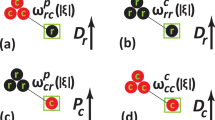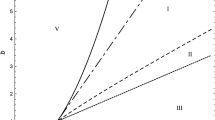Abstract
The effect of varying habitat dimensionality on the dynamics of a model predator-prey system is examined using an individual-based simulation. The general results are that in one dimension fluctuations in abundance of prey and predators occur over a large range of spatial scales (extinctions occur over many spatial scales). In two dimensions (and low mobilities of prey and predators) the dynamics become more predictably periodic at local scales and constant at larger scales due to statistical stabilization. In three dimensions, the model can become “phase-locked” with prey and predators displaying oscillations in abundance over large spatial scales.
Similar content being viewed by others
References
Briand, F. and J. E. Cohen. 1987. Environmental correlates of food chain length.Science 238, 956–960.
Comins, H. N., M. P. Hassell and R. M. May. 1992. The spatial dynamics of host-parasitoid systems.J. Animal Ecology 61, 753–748.
DeAngelis, D. L. and L. J. Gross (eds) 1992.Individual-based Models and Approaches in Ecology: Populations, Communities, and Ecosystems. New York: Chapman and Hall.
de Roos, A. M., E. McCauley and W. G. Wilson. 1991. Mobility versus density-limited predator-prey dynamics on different spatial scales.Proceedings of the Royal Society of London (Series B) 246, 117–122.
Ermentrout, B., J. Campbell and G. Oster. 1986. A model for shell patterns based on neural activity.The Veliger 28, 369–388.
Frisch, U., B. Hasslacher and Y. Pomeau. 1986. Lattice gas automata for the Navier-Stokes equation.Phys. Rev. Lett. 56, 1505–1509.
Harrison, S. 1991. Local extinction in a metapopulation context: an empirical evaluation.Biol. J. Linnean Soc. 42, 73–88.
Huang, K. 1987.Statistical Mechanics. New York: Wiley.
Kirkpatrick, S. and E. P. Stoll. 1981. A very fast shift-register sequence random number generator.J. Compu. Phys. 40, 517–526.
MacArthur, R. H. and E. O. Wilson. 1967.The Theory of Island Biogeography. Princeton: Princeton University Press.
Marek, M. and I. Stuchl. 1975. Synchronization in two interacting oscillatory systems.Biophys. Chem. 3, 241–248.
McCauley, E., W. G. Wilson and A. M. de Roos. 1993. Dynamics of age-structured and spatially-structured predator-prey interactions: individual-based models and population-level formulations.Am. Naturalist 142, 412–442.
Milne, B. T. 1992. Spatial aggregation and neutral models in fractal landscapes.Am. Naturalist 139, 32–57.
Murray, J. D. 1989.Mathematical Biology. Biomathematics, Volume 19. Berlin: Springer.
Poland, D. 1989. The effect of clustering on the Lotka-Volterra model.Physica D 35, 148–166.
Smith, C. H. 1983. Spatial trends in Canadian Snowshoe hare,Lepus americanus, population cycles.Can. Field Naturalist 97, 151–160.
Stauffer, D. 1985.Introduction to Percolation Theory. London: Taylor and Francis.
Whitehead, H. and S. J. Walde. 1992. Habitat dimensionality and mean search distances of top predators: implications for ecosystem structure.Theor. Popul. Biol. 42, 1–9.
Wilson, W. G., A. M. de Roos and E. McCauley. 1993. Spatial instabilities within the diffusive Lotka-Volterra System: individual-based simulation results.Theor. Popul. Biol. 43, 91–127.
Wilson, W. G. and W. G. Laidlaw. 1992. Microscopic-based fluid flow invasion simulations.J. Statist. Phys. 66, 1165–1176.
Wilson, W. G., W. G. Laidlaw and D. A. Coombe. 1994. Microscopic-based fluid flow invasion simulations II: mobilization and cohesion.J. Statist. Phys. 75, 1885–1195.
Wu, F. Y. 1982. The Potts Model.Rev. Mod. Phys. 54, 235–268.
Ziegler, B. P. 1977. Persistence and patchiness of predator-prey systems induced by discrete event population exchange mechanisms.J. Theor. Biol. 67, 687–713.
Author information
Authors and Affiliations
Rights and permissions
About this article
Cite this article
Wilson, W.G., McCauley, E. & De Roos, A.M. Effect of dimensionality on Lotka-Volterra predator-prey dynamics: Individual based simulation results. Bltn Mathcal Biology 57, 507–526 (1995). https://doi.org/10.1007/BF02460780
Received:
Accepted:
Issue Date:
DOI: https://doi.org/10.1007/BF02460780




